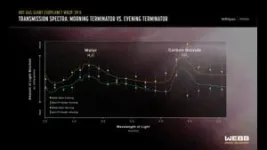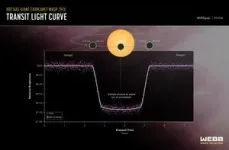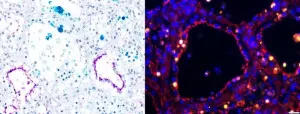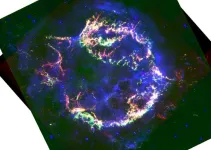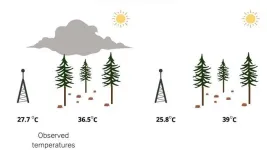(Press-News.org) Researchers using NASA’s James Webb Space Telescope have finally confirmed what models have previously predicted: An exoplanet has differences between its eternal morning and eternal evening atmosphere. WASP-39 b, a giant planet with a diameter 1.3 times greater than Jupiter, but similar mass to Saturn that orbits a star about 700 light-years away from Earth, is tidally locked to its parent star. This means it has a constant dayside and a constant nightside—one side of the planet is always exposed to its star, while the other is always shrouded in darkness.
Using Webb’s NIRSpec (Near-Infrared Spectrograph), astronomers confirmed a temperature difference between the eternal morning and eternal evening on WASP-39 b, with the evening appearing hotter by roughly 300 Fahrenheit degrees (about 200 Celsius degrees). They also found evidence for different cloud cover, with the forever morning portion of the planet being likely cloudier than the evening.
Astronomers analyzed the 2- to 5-micron transmission spectrum of WASP-39 b, a technique that studies the exoplanet’s terminator, the boundary that separates the planet’s dayside and nightside. A transmission spectrum is made by comparing starlight filtered through a planet’s atmosphere as it moves in front of the star, to the unfiltered starlight detected when the planet is beside the star. When making that comparison, researchers can get information about the temperature, composition, and other properties of the planet’s atmosphere.
“WASP-39 b has become a sort of benchmark planet in studying the atmosphere of exoplanets with Webb,” said Néstor Espinoza, an exoplanet researcher at the Space Telescope Science Institute and lead author on the study. “It has an inflated, puffy atmosphere, so the signal coming from starlight filtered through the planet’s atmosphere is quite strong.”
Previously published Webb spectra of WASP-39b’s atmosphere, which revealed the presence of carbon dioxide, sulfur dioxide, water vapor, and sodium, represent the entire day/night boundary – there was no detailed attempt to differentiate between one side and the other.
Now, the new analysis builds two different spectra from the terminator region, essentially splitting the day/night boundary into two semicircles, one from the evening, and the other from the morning. Data reveals the evening as significantly hotter, a searing 1,450 degrees Fahrenheit (800 degrees Celsius), and the morning a relatively cooler 1,150 degrees Fahrenheit (600 degrees Celsius).
“It’s really stunning that we are able to parse this small difference out, and it’s only possible due Webb’s sensitivity across near-infrared wavelengths and its extremely stable photometric sensors,” said Espinoza. “Any tiny movement in the instrument or with the observatory while collecting data would have severely limited our ability to make this detection. It must be extraordinarily precise, and Webb is just that.”
Extensive modeling of the data obtained also allows researchers to investigate the structure of WASP-39 b’s atmosphere, the cloud cover, and why the evening is hotter. While future work by the team will study how the cloud cover may affect temperature, and vice versa, astronomers confirmed gas circulation around the planet as the main culprit of the temperature difference on WASP-39 b.
On a highly irradiated exoplanet like WASP-39 b that orbits relatively close to its star, researchers generally expect the gas to be moving as the planet rotates around its star: Hotter gas from the dayside should move through the evening to the nightside via a powerful equatorial jet stream. Since the temperature difference is so extreme, the air pressure difference would also be significant, which in turn would cause high wind speeds.
Using General Circulation Models, 3-dimensional models similar to the ones used to predict weather patterns on Earth, researchers found that on WASP-39 b the prevailing winds are likely moving from the night side across the morning terminator, around the dayside, across the evening terminator and then around the nightside. As a result, the morning side of the terminator is cooler than the evening side. In other words, the morning side gets slammed with winds of air that have been cooled on the nightside, while the evening is hit by winds of air heated on the dayside. Research suggests the wind speeds on WASP-39 b can reach thousands of miles an hour!
“This analysis is also particularly interesting because you’re getting 3D information on the planet that you weren’t getting before,” added Espinoza. “Because we can tell that the evening edge is hotter, that means it’s a little puffier. So, theoretically, there is a small swell at the terminator approaching the nightside of the planet.”
The team’s results have been published in Nature.
The researchers will now look to use the same method of analysis to study atmospheric differences of other tidally locked hot Jupiters, as part of Webb Cycle 2 General Observers Program 3969.
WASP-39 b was among the first targets analyzed by Webb as it began regular science operations in 2022. The data in this study was collected under Early Release Science program 1366, designed to help scientists quickly learn how to use the telescope’s instruments and realize its full science potential.
The James Webb Space Telescope is the world's premier space science observatory. Webb is solving mysteries in our solar system, looking beyond to distant worlds around other stars, and probing the mysterious structures and origins of our universe and our place in it. Webb is an international program led by NASA with its partners, ESA (European Space Agency) and CSA (Canadian Space Agency).
END
NASA’s Webb investigates eternal sunrises, sunsets on distant world
2024-07-15
ELSE PRESS RELEASES FROM THIS DATE:
Receptors make dairy cows a prime target for influenza, ISU team finds
2024-07-15
AMES, Iowa – As highly pathogenic avian influenza has spread in dairy herds across the U.S., the virus is being detected in raw milk. A new study by a broad team of researchers at Iowa State University’s College of Veterinary Medicine helps explain why.
Sialic acid, a sugar molecule found on the surface of some animal cells, acts as a receptor for influenza. Without sialic acid providing an entry point to attach, invade and infect, a flu virus is unlikely to find a potential host hospitable.
Before the recent HPAI outbreak ...
A new neural network makes decisions like a human would
2024-07-15
Humans make nearly 35,000 decisions every day, from whether it’s safe to cross the road to what to have for lunch. Every decision involves weighing the options, remembering similar past scenarios, and feeling reasonably confident about the right choice. What may seem like a snap decision actually comes from gathering evidence from the surrounding environment. And often the same person makes different decisions in the same scenarios at different times.
Neural networks do the opposite, making the same decisions each time. Now, Georgia Tech researchers in Associate Professor Dobromir Rahnev’s lab are ...
Wojtusiak to use artificial intelligence to help caregivers with social isolation
2024-07-15
Janusz Wojtusiak, Professor, Health Administration and Policy, College of Public Health, is set to receive funding for the project: “An Artificial Intelligence Solution to Social Isolation and Longlines of Caregivers of People with Dementia.”
Wojtusiak and his graduate student Ghaida Alsadah will lay the foundation for a large study aimed at utilizing AI methods to address social isolation and loneliness among people who care for those with Alzheimer’s Disease and those suffering from dementia.
Addressing ...
You're just a stick figure to this camera
2024-07-15
Images
A new camera could prevent companies from collecting embarrassing and identifiable photos and videos from devices like smart home cameras and robotic vacuums. It's called PrivacyLens and was made by University of Michigan engineers.
PrivacyLens uses both a standard video camera and a heat-sensing camera to spot people in images from their body temperature. The person's likeness is then completely replaced by a generic stick figure, whose movements mirror those of the person it stands in for. The accurately animated stick figure allows a device relying on the ...
Scorching storms on distant worlds revealed in new detail
2024-07-15
Astronomers have created the most detailed weather report so far for two distant worlds beyond our own solar system.
The international study – the first of its kind – reveals the extreme atmospheric conditions on the celestial objects, which are swathed in swirling clouds of hot sand amid temperatures of 950C.
Using NASA’s powerful James Webb Space Telescope (JWST), researchers set out to capture the weather on a pair of brown dwarfs – cosmic bodies that are bigger than planets but smaller than stars.
These brown dwarfs, named collectively ...
JWST unveils stunning ejecta and CO structures in Cassiopeia A's young supernova
2024-07-15
July 15, 2024, Mountain View, CA -- The SETI Institute announced the latest findings from the James Webb Space Telescope (JWST) of the supernova remnant, Cassiopeia A (Cas A). These observations of the youngest known core collapse supernova in the Milky Way provide insights into the conditions that lead to the formation and destruction of molecules and dust within supernova ejecta. The study’s findings change our understanding of dust formation in the early universe in the galaxies detected by JWST 300 million years after the Big Bang. ...
UC Irvine Earth system scientists discover missing piece in climate models
2024-07-15
Irvine, Calif., July 15, 2024 — As the planet continues to warm due to human-driven climate change, accurate computer climate models will be key in helping illuminate exactly how the climate will continue to be altered in the years ahead.
In a study published in the Journal of Geophysical Research: Atmospheres, a team led by researchers from the UC Irvine Department of Earth System Science and the University of Michigan Department of Climate and Space Sciences and Engineering reveal how a climate model commonly used by geoscientists currently overestimates ...
Wildfire smoke has a silver lining: It can help protect vulnerable tree seedlings
2024-07-15
CORVALLIS, Ore. – Forest scientists at Oregon State University studying tree regeneration have found that wildfire smoke comes with an unexpected benefit: It has a cooling capacity that can make life easier for vulnerable seedlings.
An OSU College of Forestry collaboration led by faculty research assistant Amanda Brackett made the discovery while working to determine the effect of forest canopy cover on summer maximum temperatures near ground level.
The study’s goal was to describe how heat waves and other future climate conditions might affect canopy cover’s influence on temperature. The scientists used previously established heat stress responses of seedlings from ...
How does superglue work, and what the heck is electroadhesion? (video)
2024-07-15
WASHINGTON, July 15, 2024 — How would you stick a slice of banana to a sheet of copper? Until a few months ago, you couldn’t. But a new discovery called “hard-soft electroadhesion” enables chemists to stick almost any hydrogel to almost any metal, using nothing but an electric current. And you can unstick the materials simply by reversing the current. Recently reported in ACS Central Science, this astonishingly general phenomenon works with a wide variety of gels (including fruits, vegetables, meat and fish) and conductors (including metals and graphite). Join our host George as he attempts to replicate electroadhesion in his basement ...
Progression from pre-symptomatic to clinical type 1 diabetes after COVID-19 infection
2024-07-15
About The Study: Follow-up of youth with pre-symptomatic type 1 diabetes demonstrated that the COVID-19 pandemic was associated with an accelerated progression to clinical disease and that this acceleration was confined to those with COVID-19. Further studies are required to determine whether COVID-19 also accelerates progression to type 1 diabetes in adults and whether vaccination and monitoring for COVID-19 symptoms should be considered for individuals with pre-symptomatic type 1 diabetes.
Corresponding ...

